How to create a secret folder in Windows 11 and 10
Folder Guard makes it easy to create a private folder on your Windows computer and use that folder to keep the files you don't want other users to see. For example, you might be writing a diary on your Windows computer and of course you don't want someone else to read it. Or, you are writing a screenplay that for sure is going to be a blockbuster, and you don't want someone else to steal your brilliant idea. Or maybe you don't want the kids playing games on your PC to mess with the bank statements you keep on your computer. Whatever the reason you have for creating a secret folder to store the private files, Folder Guard is the tool for that.
Step 1. Download and install Folder Guard
The first thing to do, of course, is to download and install Folder Guard, if you have not done so yet. Don't worry, the download if free and it comes with a free 30-day license of full use, no credit card required to try it. If you find it not useful, you can remove it from the computer just like any other software, using Windows Control Panel.
Step 2. Run Folder Guard application
If this is the first time time you are running Folder Guard, you should see the prompt to set up the folder protection when you launch Folder Guard using the desktop icon or Windows Start menu:
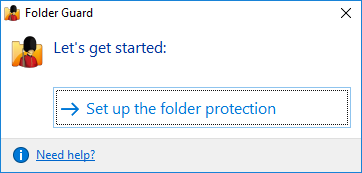
If you've used Folder Guard before, you should see a bit different screen with the link to change folder protection settings at the bottom:
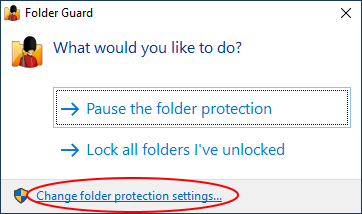
Now it's time to set up restrictions for the secret folder.
Folder Guard offers several methods of protecting your private folder, each having it's own advantages. For our case, we want to create a secret folder that would be invisible to the casual user. In other words, we want to make the folder hidden. The way to set up the visibility restrictions of a folder with Folder Guard is to use the Restricted view of the main Folder Guard window:
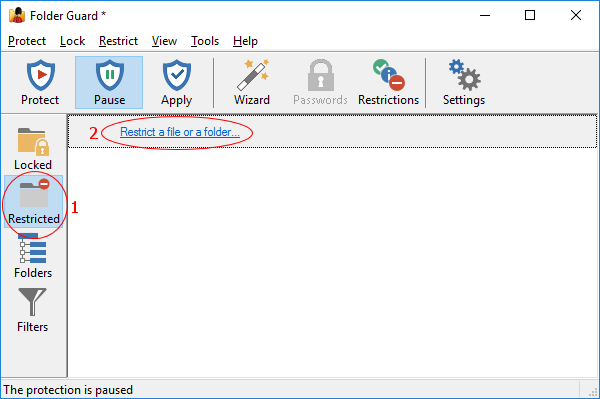
If you have not set up any restrictions yet, the list should contain just one link, Restrict a file or a folder. Click on it, and a wizard should appear that will help us set up the proper restrictions.
Step 3. Select the folder that you want to be secret
If you are just testing Folder Guard, you may want to create a test folder on the desktop or under the Documents folder, or somewhere else on your computer. Press the Browse for folder button and select the folder that you want to become secret:
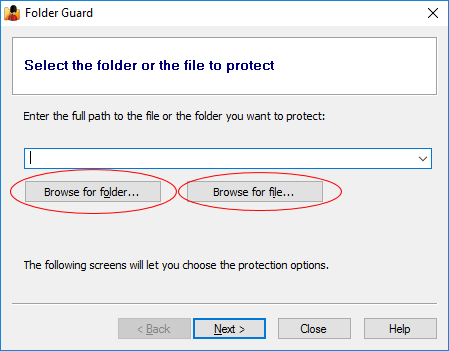
Step 4. Choose to hide folder
We want the folder we've chosen to be secret, so we use the next screen to select the option to make the secret folder hidden:
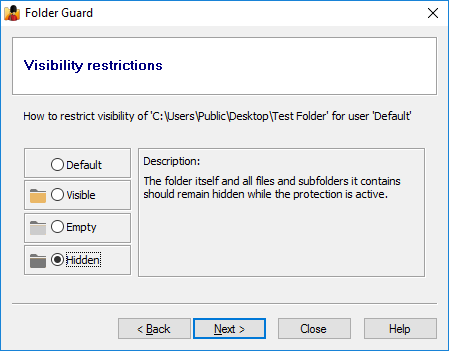
Step 5. Prevent access to the secret folder
Press Next, and another screen should appear giving you options for restricting access to the secret folder. We select the No access option, to make sure that if someone were to guess the name of our secret folder and attempt to open files in it without actually seeing the folder, such attempts would be stopped by Folder Guard:
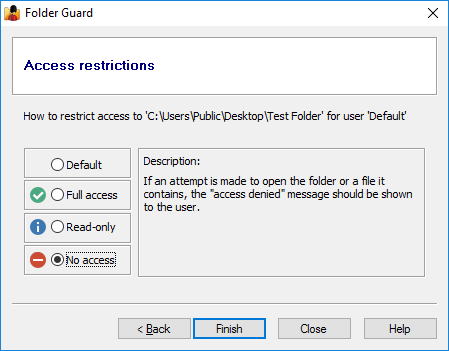
Step 6. Enable the protection of folders
The restrictions of our secret folder are all set at this point. The last step is to tell Folder Guard to start protecting the computer using the settings we've just created. To do that, press the Protect button on the toolbar, or press Apply if the protection is already on. You can also exit Folder Guard application and reply Yes when it prompts you to continue to protect the computer:
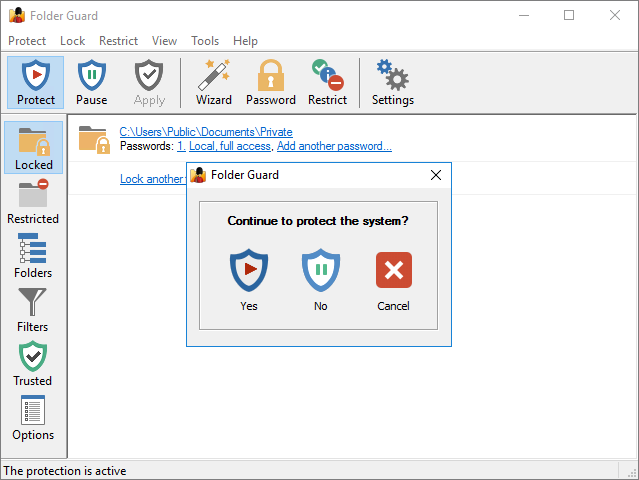
At this point, if you try to use Windows File Explorer to browse your computer, you should not see the secret folder (we told Folder Guard to keep our secret folder hidden, remember?) So if someone else is using your computer, they would not see the secret folder either. However, what if you want to see the secret folder and add something to your diary or edit that screenplay of yours? Run Folder Guard using the desktop icon or Start menu, and choose Pause the folder protection:
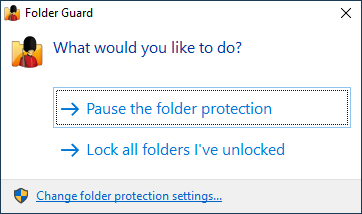
Enter the Folder Guard password that you've set up when you've installed Folder Guard, and the protection will pause: your secret folder should become visible and accessible again. You can open the files from the secret folder, edit them, save the files back, as usual. When done making changes to your secret files, run Folder Guard again and choose to resume the protection:
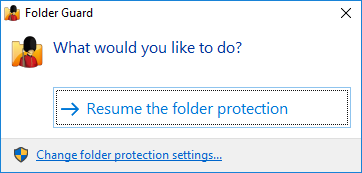
The secret folder should become invisible again.
![]() Password-protect and hide personal files and folders with Folder Guard for Windows 11,10,8,7.
Password-protect and hide personal files and folders with Folder Guard for Windows 11,10,8,7.
User rating: ![]() 4.7 / 5
4.7 / 5
Purchase
or
download a free trial.
Read more...
As you can see, Folder Guard is making it easy to create and maintain the secret Windows folder. If you have not tried it yet, please feel free to download Folder Guard free of charge. It comes with a free 30-day license of full use, no credit card required to try it.
Happy computing! And good luck with the screenplay.
Folder Guard User's Guide • Videos • Download • Purchase
If you want to link to this article, you can use this HTML code: <a href="https://www.winability.com/how-to-create-a-secret-folder-with-folder-guard-for-windows/">How to create a secret folder in Windows 11 and 10</a>
More information
- Encryptability vs Folder Guard: which one to choose?
- What people are saying about Folder Guard...
- How to enable or disable test signing mode in Windows
- Folder Guard videos
- A FREE 30-day license is included
- What's new in the new version
- Folder Guard licenses explained
- End User License Agreement (ELUA)
- Emergency Recovery Utility
- How to lock folders and drives with passwords
- How to hide folders and files
- How to unhide a folder hidden with Folder Guard
- How to create a secret folder in Windows 11 and 10
- How to restrict access to Windows Settings
- How to restrict access to Control Panel
- How to set up Folder Guard to stop downloading from the Internet
- Locking access to the external drives with Folder Guard
- How to make Folder Guard recognize network drives
- Preventing installations of specific programs with Folder Guard
- How to restrict access to Task Manager with Folder Guard
- How to restrict access to Microsoft Store app with Folder Guard.
- How to password-protect a USB flash drive
- Always have a backup of your important files

 Stand with Ukraine
Stand with Ukraine

